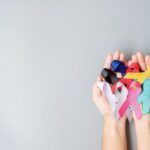
Benign breast lumps can be diagnosed among both men and women. However, the possibility of finding one is manifold higher in women than it is in men. Benign breast conditions may affect girls from as early an age as 15 years to women up to 35 years or more. The condition is mostly caused due to varied changes in the hormonal levels within the body of the women, due to estrogen and progesterone levels fluctuating during various phases of the menstrual cycle. Any kind of benign tumor or cell growth means that the mass is not malignant i.e., non-cancerous and thus, not deadly.
There are several types of benign breast conditions that may affect women throughout their reproductive period. In general, benign breast diseases affect both the breasts and can be felt as smooth and movable lumps almost in the same region on either of the breasts. These can be caused due to several reasons and may get dissolved over time without treatment. Although benign tumors are non-cancerous, in rare cases they retain the possibility of dominant malignancy, which is when the individual must seek breast cancer treatment without delay.
What Are the Causes of Breast Lumps?
Breast lumps or a feeling of mass on one or both breasts is enough to create panic among women. However, the seriousness of the condition is only dependent on the type and origin of the lump diagnosed. Breast lumps are not always harmful and may also be felt due to hormonal changes. These lumps go away after a period of time. However, some other types of lumps are severe and need to be medically monitored or operated. The variation is highly dependent on the causative agent or the reason which has led to the formation of such lumps. Most common causes are:
Cysts
Breast cysts mostly affect young women, but occur in older women as well. These are sacs filled with fluids secreted from the glands, blood, etc. In general, cysts are harmless and show no sign of malignancy. These show gradual growth and usually stay restricted to their origin.
- Abscess: Abscess in breast occurs due to fungal or bacterial infection. The infection may either originate at the place of abscess or may be spread through blood circulation from other regions like lung infection.
- Fibroadenoma: These are benign tumors or mass growth which are felt as a breast lump. Occurring mostly in young women, a fibroadenoma may affect both the breasts at once.
- Fat necrosis: Dead and damaged adipose cells aggregated from ischemic breast disorders accumulate in the form of lumps. These are nonviable and non-cancerous in nature and often result from physical trauma or prior history of operation in the breast.
- Lipoma: Mostly occurring women above 40 years to 60 years of age, lipomas are tumors formed of fat cells that are benign in nature.
Can You Determine Whether Breast Lumps As Benign or Cancerous
To determine the malignancy of a breast lump, a medical diagnosis is extremely essential. In approximately 90% of reported cases, lumps felt in either or both breasts are benign in nature and non-cancerous. However, with an increasing count of breast cancer cases, it is mandatory to physically examine oneself to stay aware. In general, malignant breast lumps are painless, which is why it becomes hard to detect the presence of one. These lumps, if hard or stiff and shows signs if rough edges, may indicate malignancy.
However, no conclusion can be drawn without medical evidence confirming the condition. Hence, breast ultrasound along with a mammogram should be performed on the suspected breast in order to determine the malignancy of the lump. Further confirmatory tests include:
- MRI scan: For obtaining defined images indicating any kind of abnormality.
- Fine Needle Aspiration or FNA, in which fluids containing cells are drawn from the breast lump and tested.
- Biopsy: A sample mass tissue is removed from the mass or lump and tested for cancer.
When to Go for Treatment
Breast lumps are mostly not cancerous and are benign in nature. Some of the cysts or fibroadenomas go away on their own over a period of time. However, in case the lumps do not get dissolved, further medical attention is required. Breast cancer treatments are only preferred after a thorough evaluation of the lump and confirmatory evidence of its malignancy.
Surgery
Surgical procedures for the same include:
- Lumpectomy: Surgical removal of the breast lump.
- Mastectomy: Surgical removal of affected or damaged tissues in the breast.
- Chemotherapy: Specific drugs are provided in the form of pills or injections which destroy the cancerous cells.
- Radiation therapy: High energy radiation beams are focused and targeted over the affected region or tumor and destroyed.
- Climate Change Is Creating a Mounting Health Problem for Millions of People - March 1, 2021
- Use These Handy Tips to Set Up a Wireless Network - April 3, 2020
- Benign Breast Lumps: Causes and When to Call a Doctor - March 27, 2020






